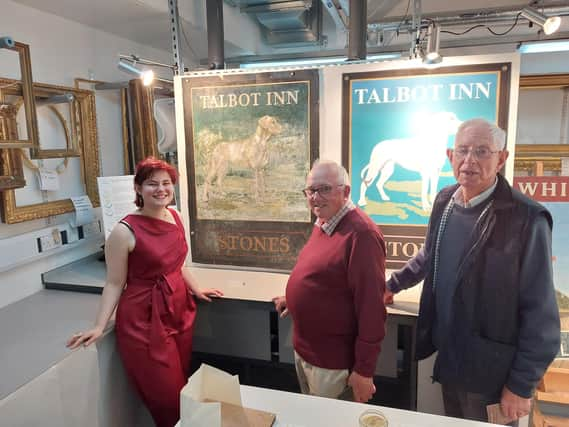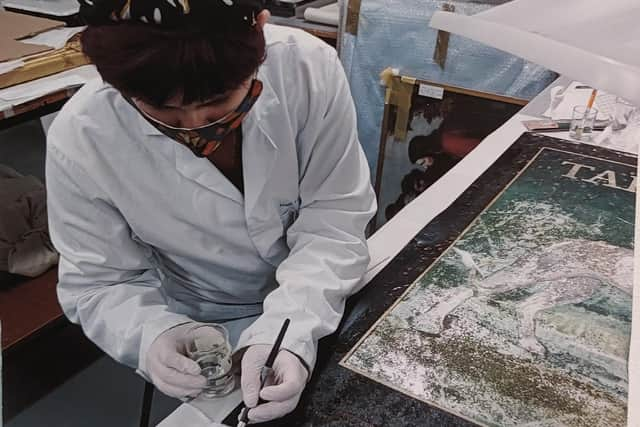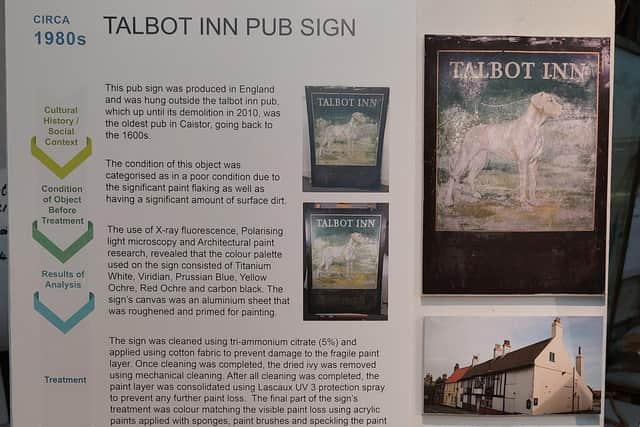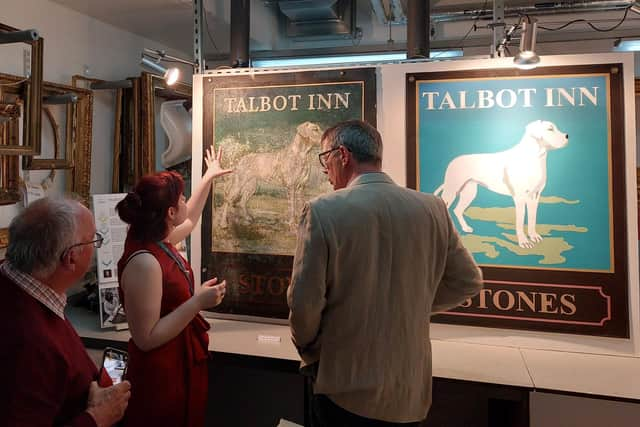Talking of the Talbot at Caistor


The Talbot Inn is now home to the town’s Lincolnshire Co-op store, but long-time residents have many fond memories of meeting with friends and holding special events at the venue.
The talk on The Talbot Inn – memories, conservation & history, will be held in the Caistor Town Hall Arts Room, starting at 7.30pm. Admission £4.
Advertisement
Hide AdAdvertisement
Hide AdThe pub’s sign is one of the things that has been saved and it has recently undergone conservation at the University of Lincoln, in the capable hands of third-year student Nellie-Mae Morgan.


Nellie said: “I have very fond memories of going to pubs as a child with my family for pub lunches and I loved the atmosphere and the amazing food.
"When I saw this sign during my first year, I decided that if I was given the chance to work on it I would.
“In my third year, we were given the chance to select and amongst all the objects there was Talbot leaning against a wall and ready to be claimed.
Advertisement
Hide AdAdvertisement
Hide Ad"After talking to Alan Dennis from Caistor Heritage, I could see how much love this sign had from everyone who remembers the pub and all the wonderful memories.


"Being a part of this sign’s history has been a great honour and privilege.”
Nellie said her greatest concern was the sign’s flaking paint, likely to have happened due to the object being outside for decades.
She painstakingly cleaned the surface of the sign and then consolidated the existing paint before carefully colour matching the paint to replace missing sections.
Advertisement
Hide AdAdvertisement
Hide AdNellie explained the process: “The materials used for this object were researched and investigated using various analytical techniques, which revealed that the materials likely used are an aluminium sheet and lead based oil paints.


"The use of an aluminium sheet as the canvas does pose problems due to aluminium reacting with the outside condition. This causes the aluminium to create an oxidised layer, which has caused the paint to attach to the oxidised layer which is still oxidising, causing the paint to flake, and causing further loss of paint.
"In order to control this, the whole sign needed to be consolidated to secure the paint. For this to be successful, I needed to clean the surface of the sign of all the surface dirt, which included using tri-ammonium citrate at 5 per cent on cotton fabric and placed onto the surface and left for 5-10 minutes to remove the surface dirt without removing paint flakes.
“Once cleaning was completed, the sign was consolidated with six coats of consolidant, which helped to secure the paint flakes.
Advertisement
Hide AdAdvertisement
Hide Ad"Once this was completed, I colour-matched paint losses that obscured the aesthetic value of the object, which involved using golden acrylics, paint brushes and sponges to create the same damaged effect of the original paint to help blend the new retouches.”
During the treatment of the sign, Nellie worked on a recreation of the pub sign before damage using photoshop, to show what the pub sign would have looked like before damage, meaning the two versions could sit side by side.
The original sign and the recreation were hung in the end of year exhibition for the third year students
this summer.
Pleased with the outcome, Nellie used the sign as a catalyst for her dissertation, discussing the use of materials used for pub signs and how this effects their longevity.
Advertisement
Hide AdAdvertisement
Hide AdNellie has participated in the BA(hons) Conservation of cultural heritage course at the university of Lincoln, working on different object to learn the techniques and skills used for object treatment.
Throughout the three years, she has worked on metal objects, ceramics, archaeological objects, frames, gilded frames and the pub sign.
She said: “ I have enjoyed every minute of my course and I am now moving to my masters in conservation of cultural heritage at the university of Lincoln and after this course plan to work on decorative arts objects, such as wall paintings and gilded objects.
"For me objects tell a visual story to people and mean a lot to people, being a part of an object’s history is a huge privilege and I make sure that all objects I work on have the best possible treatment.
Advertisement
Hide AdAdvertisement
Hide Ad"I am a huge museum and object fan and absolutely love learning about an objects history. When I
was a child, I was taken to loads of museum by my parents which sparked a flame from a young age.
“My parents encouragement and help has meant everything to me and has helped me pursure conservation.
"I also want to thank the conservation department at the University of Lincoln for all their support in helping me become the best conservator I can be and thank you to Lincoln Conservation for having me for my placement in year 2; all their knowledge and passion has helped me become a better conservator.
Alan Dennis, who commissioned the work on behalf of Caistor Heritage, said: “We can’t thank Nellie enough for the work she has done. An excellent job to preserve the sign for the future.”